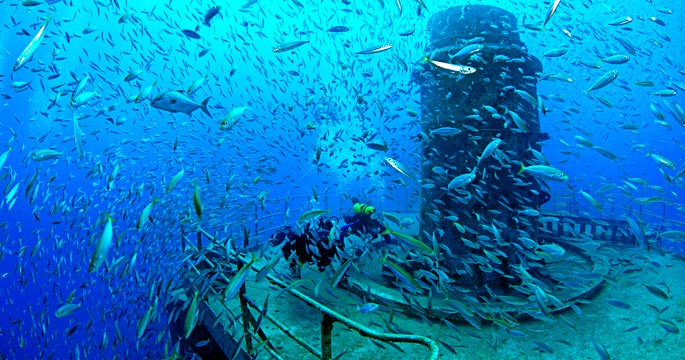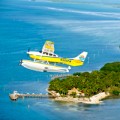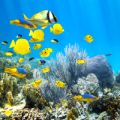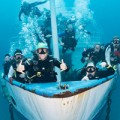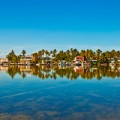The Florida Keys Shipwreck Trail blends history and nature under the sea
It’s common to see visitors to the Florida Keys stand in awe as they gaze upon the sparklingly clear blue-green water that surrounds the island chain. Take a peek beneath the surface, though, and there’s much more to see. Not only does the water teem with vibrant coral reefs and schooling fish, but it’s a treasure trove of shipwrecks dating as far back as the 18th century. More than 10 ships make up the Florida Keys Shipwreck Trail, or “wreck trek,” creating an underwater playground for snorkelers and divers. Local dive shops rent any gear you might need and can pair you with a dive buddy if you’re traveling solo.
Key Largo Favorites
Several of the wrecks lie off of Key Largo, where dive operators like Horizon Divers and Island Ventures take aquatic adventurers to explore the remains of these ships. The City of Washington sank in just 25 feet of water, making this a prime spot for snorkelers. Clear visibility means it’s easy to spot the moray eels and nurse sharks that call the area home and see the pieces of the ship, which sank in 1917. The wreckage is scattered along 325 feet of seafloor, but you can follow the outline of what’s left of the hull and watch schools of jacks and yellow-striped grunts swim through the engine mount and coral-covered pieces of deck ladders. The Benwood, which sank in a collision during World War II, is a diver’s paradise. The hull, fractured but intact up to the first deck, fills your entire view from the surface. Dive 25 feet and swim over the wreck to spot barracuda hovering above the deck and goliath grouper lurking in the cracks and crevices. Go down another 20 feet to swim along the hull and see a plethora of colorful hard corals and sea urchins that have attached themselves to the walls. Keep an eye out for the dye bomb from when the Benwood was used for aerial target practice.
Divers wanting to go bigger will also have to go a bit deeper to explore the massive superstructures of the 510-foot USS Spiegel Grove, which rises some 60 feet above a 130-foot-deep sand bottom. Put down after years of meticulous planning and preparation, this former Navy landing ship made headlines when it turned turtle a day before its planned sinking, then stubbornly refused to put its bow under. When it finally did sink, the ship came to rest on its side. Three years later a storm surge from Hurricane Dennis rolled it upright, and it has now become the Key’s favorite wreck.
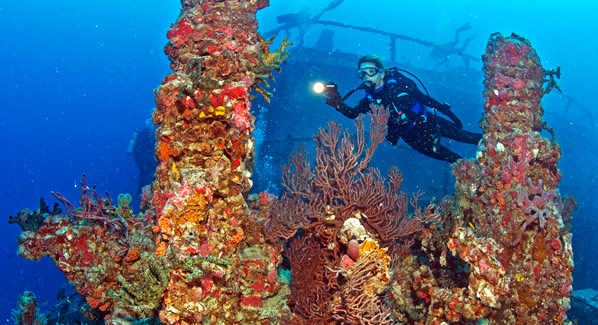
After a decade in the water, portions of the USS Spiegel Grove are now covered in a colorful carpet of corals and sponges, adding an extra degree of interest to the ship. Photo: Stephen Frink/Florida Keys News Bureau
Where to Stay: A waterfall pool, private beach and balconies overlooking the Florida Bay make the Hilton Key Largo Resort a prime spot for your time spent topside. Proximity to John Pennekamp Coral Reef State Park and marinas used by many Key Largo dive shops makes the Hilton a popular choice with visiting divers. But if your plan is to engage in more water-sports adventures than diving, you’ll find parasailing, windsurfing, kayaking and paddleboarding, along with Hobie Cat rentals at the resort’s beach. Exhausted and hungry at the end of the day, guests just head to the resort’s Treetops Bar & Grill for platters of seafood.
Marathon and Beyond
Head west to Marathon and hook up with Tilden’s Scuba Center for a trip to the resting place of the Adelaide Baker, just off of Duck Key. The only big piece that remains of this 1889 wreck is the main mast, but the debris lies in the midst of a thriving reef with visibility that snorkelers and divers crave. It’s just 20 feet deep, which gives snorkelers a clear view of the colorful parrotfish and porkfish that dart around the brain coral and sea fans the reef is known for. On the deep side of the reef, and a few miles to the west, the intentionally-sunk freighter Adolphus Busch serves as a fish haven and attracts divers comfortable at depths of 80 to 100 feet. To cap off a Key’s wreck adventure, divers can head to the end of the highway in Key West to discover the USNS Vandenberg, a former troop transport and missile-tracking ship that is the latest addition to the wreck trek. This 17,120-ton behemoth—the biggest wreck in the Keys—was sunk as an artificial reef about seven miles off of Key West in 2009. Today it’s a regular stop for most dive centers on the island. Open-water divers can swim over the massive radar dishes and antennae, which are visible in just 40 feet of water, and deepwater divers can explore the bridge, main deck and hull, which rest at 140 feet. Coral has already started to cover much of the ship’s surface, and sea life like barracuda, grouper and snapper have moved in.
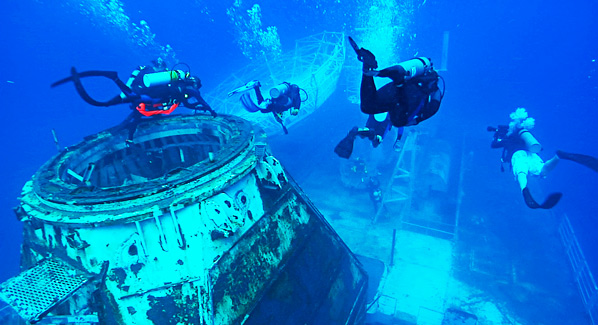
A group of divers descends on the USNS Vandenberg soon after its sinking. The large antenna dish in the background was used to track rocket launches during the space race. Photo: Haig Jacobs/Florida Keys News Bureau
Where to Stay: Hawks Cay Florida Keys Resort on Duck Key is smack in the middle of the Keys—the optimal place to base yourself for diving and snorkeling in the middle and lower Keys. Two-story villas with up to three rooms can house groups looking to get wet, and the on-site dive crew at the resort’s marina makes booking your boat a breeze. The resort’s saltwater lagoon, fed by the Atlantic and encircled by a sandy beach dotted with thatched huts and chaises, is the place to be when not out under the water. And at night a friendly crowd gathers around the poolside fire pit to toast the end of the day.
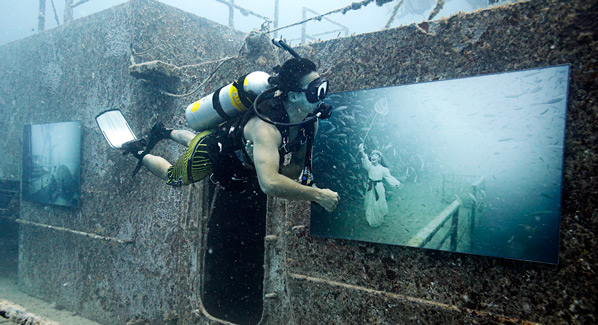
A diver examines images attached to the superstructure of the USNS Vandenberg. After gaining an underwater patina, this artwork was returned to the surface for exhibit. Photo: Andreas Franke/Florida Keys News Bureau

